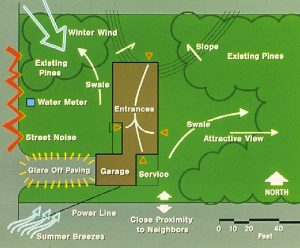
Heather Kolich, ANR Agent, UGA Extension Forsyth County
Although it’s still cold outside, seed and garden catalogs are showing up in our mailboxes. The photos of blooming flowers and prize-winning vegetables are tempting, but to get the best performance out of our spring and summer gardens, we need to do some planning and prep work.
Goals and design
Whether we’re considering seasonal color beds, vegetable gardens, or landscape additions, we need to determine what goals we want to achieve. Are we planting to hide an ugly spot, create a shady oasis, or grow food for the family? What kind of plant can meet that goal?
For the ugly spot, we probably need an evergreen bush that keeps its leaves year-round. Next we need to decide how big the bush needs to be to do the job – and at what size the shrub overwhelms the space. Once we determine the functional aspects, we can consider aesthetics. Does this space need a precisely pruned form, or natural growth? Do we want flowers, and if so, what color?
Site assessment and soil testing
Once we’ve determined plant function and form, we need to analyze the characteristics of the planting area. Every landscape contains several microclimates. One area may be shady and cool, while another is sunny and hot. High areas might be exposed to windy conditions, and low spots may stay wet.
To assess the environmental conditions of the selected area, visit it several times a day and note whether it gets morning sun or afternoon sun, and for how many hours the sun shines on that spot. Note which direction the wind blows, measure the temperature, and feel how moist the soil is. Another important thing to note is the location of overhead utility lines and underground infrastructure, such as sewage, gas, and cable lines. Call 811 to have a crew come out and mark where infrastructure is buried in your yard; it’s a free service.
Soil conditions can also vary throughout the landscape. Soil analysis from the University of Georgia soil laboratory provides information on soil pH, the availability of nutrients, and advice on amending the soil to meet the needs of specific plants. Winter is a good time to apply amendments, such as lime and compost, to get soil into good condition to support healthy plant growth.
Select the right plant for the planting space
The final step is selecting the ideal plant for a specific planting site. Plants are adapted to thrive in particular environmental niches; that’s why we can have beautiful shade gardens, vibrant pollinator gardens, and stunning water gardens. But plants in the wrong environment suffer from stress. They may be more susceptible to pest problems, and they almost never live up to our expectations of beauty or productivity.
Let’s say that, through the design analysis, you decided the perfect plant to hide the ugly spot is an evergreen bush that grows to 5-feet at maturity, and has a naturally rounded form so you don’t have to spend too much time pruning it. Flowers are optional. Through the site analysis, you determined that the planting site gets full afternoon sun, stays fairly dry, and is well away from buried utilities. The soil analysis shows slightly acidic soil and moderate fertility.
Now it’s time to select a shrub that meets your aesthetic needs and is adapted to the environmental conditions of the site. One great resource for landscape match-making is the UGA publication Landscape Plants for Georgia. Plants are categorized by type (tree, shrub, groundcover, etc.) and size. Plant descriptions offer information about hardiness zones, exposure, mature size, form, growth rate, texture, flower color and size, as well as comments from UGA horticulture specialists.